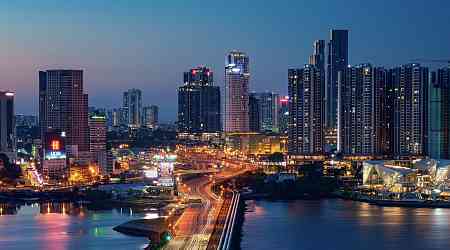
- caption
- The author, Zirui Yan, moved to the US from China when he was 19.
- source
- Zirui Yan
- I moved to the United States from China when I was 19 years old to go to college in North Carolina.
- Years later, I’ve noticed many cultural differences between my two countries.
- In many ways, Americans and Chinese people behave differently, from their eating habits to the way they spend money.
- Visit Business Insider’s homepage for more stories.
In the summer of 2016, I left my hometown of Guiyang, China, and moved to North Carolina for college.
I was a 19-year-old freshman, and everything seemed new and different to me. Not only was I trying to make new friends and adjust to college life, but I was learning to live in a completely foreign culture, too.
Three years later, I’ve noticed many cultural differences between the two countries I’ve lived in, from Americans’ relationship with money to the way they eat at restaurants. In many aspects of life, Chinese people couldn’t behave more differently.
Here are 17 of the biggest cultural differences I’ve observed between the US and China.
In the US, restaurant waiters really like to chat with you

The servers at US restaurants try hard to leave a good impression on their customers, as tips make up a large percentage of their salary.
In China, however, restaurants pay their staff a fixed income. Servers focus more on getting food on the table quickly rather than taking their time and treating the customers like their friends. And waiters in China are still just as willing to accommodate you if you want to modify your order.
Shopping at the farmers’ markets is more expensive than the food in grocery stores

- caption
- In China, grocery stores are where you buy the most expensive food.
- source
- Arina P Habich/Shutterstock
In the US, when people think of farmers markets, they often think fresh, juicy tomatoes or organic eggs from local farms. In many cases, produce at the market is more expensive because of its high quality and freshness, even when compared to the organic goods sold at chain grocery stores.
Meanwhile, in China, grocery shopping at a supermarket is the more expensive way to buy your food.
For many Chinese people, going to the local farmers market is part of their daily routine. Every morning, vendors come to the market and set up their booths, selling everything from spices to seasonal fruits and vegetables to even live fish.
Grocery stores tend to be more expensive because it’s harder to keep the produce fresh while being transported long distances. However, stores offer a cleaner and less chaotic shopping atmosphere than markets, which is why some shoppers prefer them.
People don’t usually bargain at markets in America

- caption
- Prices usually don’t budge.
- source
- Harrison Jacobs/Business Insider
Bargaining isn’t really an American thing. Once the price is set, the shoppers either accept it or move on. However, one can bargain for pretty much everything at a Chinese market. Your bargaining skills can get you cheaper groceries!
In China, even college students can afford to dine out every day

- caption
- Enjoying a meal with friends doesn’t have to be a stress on your budget.
- source
- Chandan Khanna/AFP/Getty Images
The food industry in China is massive and diverse, from hawkers on the street to high-end dining places.
For college students in China, dining outside of school cafeterias is affordable. One can buy a bowl of noodles at a noodle shop for about $1. Stir-fried dishes at local diners close to universities usually lower their prices, from $4 to $10 per dish; and hotpots start at about $9, and can feed at least two or three people.
American people drink coffee, while Chinese people drink tea

- caption
- Americans love their coffee.
- source
- Shoshy Ciment/Business Insider
China is the birthplace of tea, so it makes sense that Chinese people prefer it to coffee.
Americans, on the other hand, are obsessed with coffee – over half of Americans drink it every day, in fact, while less than a quarter drink tea.
People in the US use microwave ovens to heat their water

- caption
- Most college students I met didn’t own a kettle.
- source
- Zynatis/Shutterstock
To make drinks like instant coffee, Americans often put the powder and cold water in a cup first, put the cup into the microwave oven, heat it for three minutes, and take it out to stir it.
In China, however, since people make tea with boiling water, it’s common to have a kettle at home to do the heating.
And in the US, no one drinks hot water

- caption
- Iced coffee in the winter took some getting used to.
- source
- Mario Tama/Getty Images
The idea of yin and yang are part of the essence of the Chinese philosophy on health. If yin overtakes yang, you start to feel cold and could even catch a fever.
That’s where hot water comes into play. It warms up the body and chases away the yin inside.
However, in America, I see people drinking cold water and iced coffee all the time, even when it is 30 degrees outside. I was shocked when I saw it the first time and held on tighter to my hot latte.
When it comes to education, American parents don’t go to the same lengths as Chinese parents

- caption
- Chinese parents start investing in education once their child starts pre-school.
- source
- John Moore/Getty Images
American parents may think they take their children’s education seriously, but it’s even more drastic in China.
Chinese parents are known to purchase apartments near good schools just for their kids to have a chance to go to that school. The education marathon starts from pre-school all the way through high school.
To help their children get high scores on their high school and college exams, Chinese parents often spend extra money for their children to go to prep classes on the weekends or even hire a tutor to help them with their homework one-on-one. Famous teachers charge higher for a tutor class session, which averages at $40 an hour in a class of 20 students.
In the US, I think children have more autonomy when it comes to what kind of school they choose to go and what kind of future they want to have. American parents may stress less on getting good grades, but they broaden their children’s horizons by engaging in conversations about news and politics and participating in school projects with them.
Another difference is that parents in the US emphasize physical development to their kids more than Chinese parents do. Americans encourage their children to join sports teams and sign them up for athletic camps during the summer, which isn’t as common where I’m from.
People in China scan QR codes to pay for stuff, from bus rides to luxury purses

- caption
- Americans still use cash, especially for public transportation.
- source
- Chesnot/Getty Images
In the US, when people go out to eat or shop, they either pay cash or card. Some apartment residents even pay their rent via check or money order. It wasn’t until recently that mobile apps like PayPal and Venmo became a trendy way to pay.
That’s not the case in China. People in China are catching up to the digital age in their own way: making transactions easier via QR codes.
With the prevalence of WeChat and Alibaba, nearly all vendors offer QR codes for customers to pay. Even the government has implemented the technology into public transportation in many cities in China by allowing people to pay for their fares via QR codes. One can link cards to WeChat Pay or AliPay and start scanning.
The US is way more spread out than China

- caption
- You can get out into nature fairly quickly.
- source
- Hryshchyshen Serhii/Getty Images
If you look out the window of a plane in the US, you don’t usually see clusters of houses everywhere, unless you’re close to the airport. The US is roughly the same size as China, but has a much smaller population, which makes the US feel more spread out. The open space gives Americans a lot more opportunities to do outdoor activities like hiking and sailing.
The US has very different suburbs than China does

- caption
- In China, suburbs still have high rises, whereas suburbs in the US are made up of houses.
- source
- Henryk Sadura/Shutterstock
When you think of American suburbs, you might picture row after row of houses with big lawns, garages, backyards, and even swimming pools. There might be a shopping plaza or two nearby consisting of grocery stores, restaurants, cafes, banks and the like.
Suburbs in China are very different – in fact, they don’t look that different than cities in the US. Because of China’s enormous population, suburbs there are filled with high-rise apartments and are connected to cities by buses, trains, and subways. Big houses are much more expensive in China because space is at a premium.
Restaurants close early in the US

- caption
- It was rare to find a restaurant open past 10 pm in my college town.
- source
- Andy Cross/The Denver Post via Getty Images
Everything closes pretty early in the towns I lived in, especially affordable dining places. Most restaurants usually close before 9 p.m. For party-goers and college students, they have limited choices like pizza or Waffle House or whatever they have in their fridge.
In China, people’s food journeys are just beginning at 9 p.m. Vendors at the night markets usually sell from 9 p.m. to 3 a.m., and they have all kinds of options, from stir-fried crawfish to tofu pudding, all freshly made in front of you at affordable prices. Many vendors at popular night markets even stay open until dawn, meaning you can always find something to eat at any hour of the day.
Americans don’t care about luxury and designer brands as much as Chinese people

- caption
- Clothing is not as big of a status symbol in the US.
- source
- Hanna Lassen/WireImage
Chinese people believe in clothing as an economic status symbol, and are much more keen to buy Chanel bags and Burberry trench coats than Americans.
Meanwhile, Americans tend to spend more on experiences like sporting events, concerts, and traveling.
But luxury goods are cheaper in the US

- caption
- Designer clothing is cheaper in the US.
- source
- Reuters
China charges high tariffs for imported goods, making luxuries even more expensive than they already are. For example, a Coach Parker Top Handle bag is $350 plus tax on Coach’s US website, while the same bag costs anywhere from around $500 to $638 on Coach’s Hong Kong website.
People drive everywhere in America

- caption
- Every city was congested with traffic.
- source
- Kevork Djansezian/Getty Images
America is a country on wheels. Except for in a few major cities, Americans drive everywhere: to school, to work, to shop, to eat, and everywhere in between. That leads to everything being more spread out. It’s not crazy to drive for 30 minutes just to get to dinner.
People might walk to destinations closer to home, but in many places public transportation is not a common way to get around. Buses might come every 30 minutes, or even every hour, and Amtrak trains are slow as well. Many Amtrak trains operate at speeds slower than 100 mph, whereas the high-speed trains in China can be as fast as 217 mph.
Most Americans only speak one language — English

Although a second language is required, most Americans are only fluent in English. Some may have taken Spanish or French in school and might have a vague knowledge of the language.
In China, you can expect people who have a bachelor’s degree or higher to be able to read and write at least in intermediate English. In some Chinese provinces, people speak Mandarin as well as their local dialect. For example, most people in Guangdong province speak both Mandarin and Cantonese.
Vacations are longer in the US

- caption
- I was pleased to get more vacation time than I was used to.
- source
- Nacho Doce/Reuters
American students usually get a three-month summer vacation and winter and spring breaks that last at least one or two weeks each. Thanksgiving break often extends for a week, too. And there are many one-day breaks such as MLK Day, Fourth of July, and Labor Day.
Chinese official holidays are usually shorter. Students get a 40-day vacation in both summer and winter. For working professionals, Spring Festival and National Day are the only two holidays that are one week long. Other holidays such as Dragon Boat Festival and Mid-Autumn Festival are the only one-day vacations.
























